#but what is fun about metroidvanias seems to be 1) exploring new things and b) doing boss fights
Explore tagged Tumblr posts
Text
started trying to play hollow knight again from a fresh save, played for like two hours, got to the Exact place where i rage quit last time and remembered why i have never played more than three hours of this game in a save
#maybe i just don’t have the right metroidvania mindset.#but having to backtrack all the way to the boss fight and then continually dying and having to backtrack is SO frustrating!!!!#and trying to get money is so grindy and i have like 200 coins in the spirit thing#and i KNOW i can buy a dash/double jump somewhere bc there are obstacles that are impassable without it but i haven’t found it yet.#am i just supposed to give up that spirit and go grind elsewhere??? am i just really bad at this game???????????? help#bc i want to like this game so bad bc everyone i know who has played it is obsessed with it#but i’m having trouble making it click for me#yellings#maybe im just not a metroidvania guy.#like i love roguelikes (another genre in which dying a lot is expected) but i am not frustrated by them in the way that i am by hk#maybe because the Whole roguelike experience is built to be integral parts of the experience#but what is fun about metroidvanias seems to be 1) exploring new things and b) doing boss fights#and traversing through the tunnels to get back to a checkpoint just feels very tedious and unfun#genuine question is there something im missing or do i need to work on sucking it up and getting good
12 notes
·
View notes
Text
The Master of Blasting
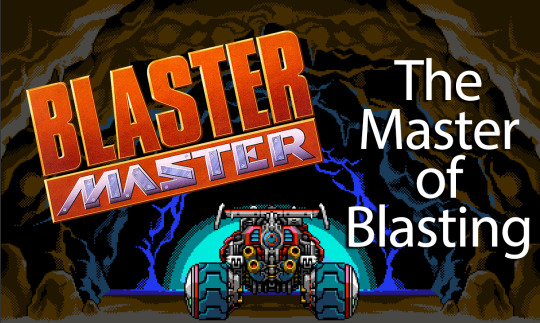
Months ago, once I realized my Retron had a save-state feature, something got into me. I realized I could go back to old retro games and actually finish them. Sure, I played 100s of games in the 8 & 16-bit eras, but I’ve never been that good at anything with a steep difficulty. Most games of the late-80s, early 90s were punishingly tough and typically, without cheat codes I never got to see the end of them.
After playing through all the old Donkey Kong Country games and Sonic the Hedgehog 1, I turned my eye towards a peculiar series I had only dabbled in before, Blaster Master. With the release of Blaster Master Zero on Switch, I was extra interested in diving into the well-regarded B-tier NES original.
With a little research, I found that a total of 8 Blaster Master games have been released...that’s when the classic Sergio completist kicked in. I convinced myself that I shouldn’t play the new Switch games until I’ve completed all of the retro titles. When I began my journey I didn’t realize it would be such a headache. Here’s my run-through of all the Blaster Master Games.
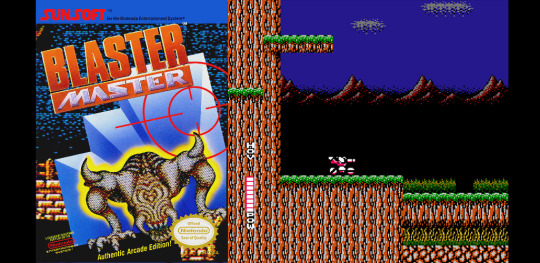
1988 - Blaster Master (NES)
Ah, the original. This little game has a charm to it that most games of the late 80′s don’t have. It was clearly inspired by Nintendo published games like Metroid and Zelda. Blaster Master’s key gimmick is the ability to play as the armored tank Sophia the 3rd or as an on-foot character named Jason, the pilot of the tank. As needed, Jason jumps out of the tank and enters human-sized doors.
Blaster Master is a 2D platformer, but once Jason enters a door, the game switches to an overhead perspective for navigation through maze-like dungeons. None of the mazes are particularly hard to solve, but all of the game’s bosses are found in these dungeons. As a kid, having a game that completely switched perspectives was rad. I never owned it as a child, but I vividly remember my time with it through rentals and such.
This first game is super hard and I found myself using known glitches to get past the game’s harder boss sequences. In true Metroidvania-style, there’s heavy backtracking throughout Blaster Master and if you don’t know where you’re going getting to the next level can be quite annoying. Having played the whole game, I can finally say that despite a super strong first impression, Blaster Master isn’t that great.
It's WAY too hard and by the halfway point the luster had worn off the unique gameplay. For some reason, this is the point where I decided to dive headfirst into the rest of the Blaster Master games. I’m a glutton for punishment I guess.
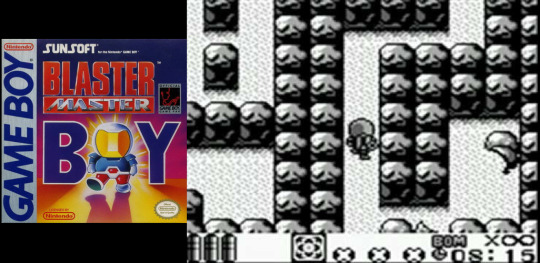
1991 - Blaster Master Boy (Game Boy)
Prior to playing the original, I had no idea there were so many titles in this series. I definitely didn’t know there were multiple portable entries. Blaster Master Boy is less a Blaster Master game and more a Bomberman game. Technically its a sequel to the Bomberman spin-off Robo-Warrior. A quick trip over to Youtube can confirm that the gameplay and music are lifted directly from Robo-Warrior. To add even more confusion, in Japan, Robo-Warrior was called Bomber-King, Blaster Master Boy was Bomber-King Scenario 2 and it wasn’t even published by the same company.
Because of this weirdness, I didn’t spend too much time with Blaster Master Boy. It also didn’t help that there isn’t a decently priced copy anywhere on the internet.
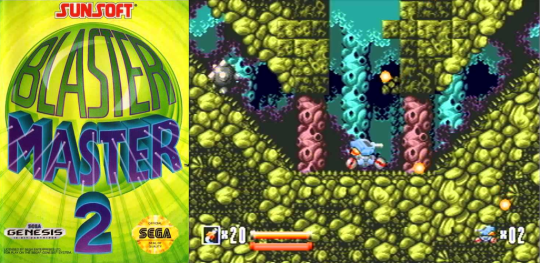
1993 - Blaster Master 2 (Genesis)
Five years after the original, Blaster Master returned to the console market with Blaster Master 2. It was a Sega Genesis exclusive and the only title in the series released in the 16-bit era. Playing this immediately after the original really made it quite hard. The controls aren’t as precise and the difficultly level is somehow ratcheted up. Blaster Master 2 is a more straight forward platformer without the backtracking of a traditional Metroidvania.
Unlike the first game, when you enter the human sections of the game, you don’t start a top-down sequence. Instead, the pilot levels are 2D platform shooter areas. All of these seem half-baked, clunky and compared to the game’s contemporaries, quite sad. Fortunately, top-down gameplay wasn’t completely abandoned, before the end of each level there’s an odd top-down sequence, where you pilot Sophia. This mechanic never returns in future games, but taking the rest of the game into consideration, it really isn’t terrible.
Unfortunately, there’s not much good to say about Blaster Master 2, It hits most of the design notes that the first one hits but the entire experience feels like it was made by a completely different team. Funny enough, after saying that, I looked it up and Blaster Master 2 was, in fact, made by a completely different team. Ha!
The game’s only saving grace is its vivid color pallet and solid sprite design. Like the first game, the music solid, but unless you’re taking a trip through the whole series like me, Blaster Master 2 can be skipped.
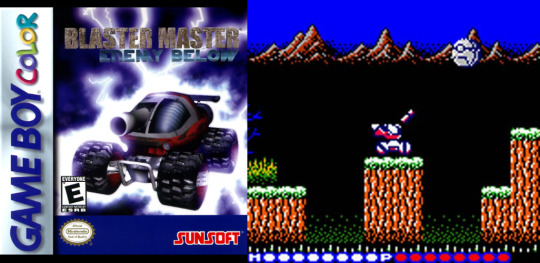
2000 - Blaster Master: Enemy Below (Game Boy Color)
It took Sunsoft awhile to get around to the Blaster Master series again, but in 2000 they came out swinging. Blaster Master: Enemy Below was released for Game Boy Color and of all the games on this list, it is the game that most resembles the original. Much of the art is designed to look nearly identical to the NES games’, even down to a nearly pixel-perfect recreation of the SOPHIA tank.
The top-down Jason segments return as does the extreme difficulty and fantastic soundtrack. It’s hard to really complain about the execution of this title. It was clearly an attempt at just trying to make the closest thing they could to the original and in many ways, it is a tighter and more consistent experience. Unfortunately, that’s also a strike against it. Enemy Below doesn’t bring anything new to the table. The bosses are basic re-hashes of the originals, the levels feel like a ��lost levels” DLC pack and the game being portable doesn’t really encourage innovation.
I guess the coolest thing I can say about Enemy Below is that it's still available for purchase. On the 3DS Virtual Console, you can pick up Enemy Below for about $5. At that price, it’s easy to recommend, especially since it comes with built-in save-state functionality.
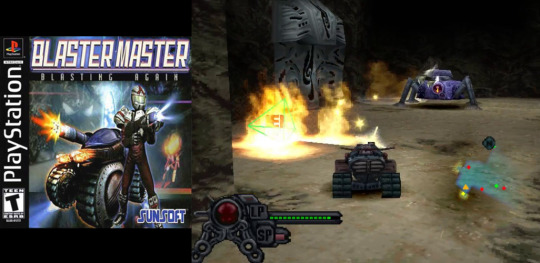
2001 - Blaster Master: Blasting Again (Playstation)
Also, released in 2000 (in Japan, 2001 in North America), is the weirdest game in the series to date, Blaster Master: Blasting Again. For those of you too young to remember, the Playstation/N64 era of video games was full of 2D series trying their hand at 3D games. Blasting Again is an egregious example of this frustrating industry trend. You still pilot a tank, with all the same features, like homing missiles, and hover, but you’re dropped into a fully realized 3D world with painfully bad anime cut-scenes.
The “Jason” sequences are still here, but they too are 3D and mundanely boring. Also, with this being an official sequel to the original, you play as Jason’s son Roddy, not Jason. Much of the music from earlier in the series is remixed, and rerecorded, so not all is lost in the odd one-off. Unfortunately, the antiquated tank controls and punishing difficulty makes Blasting Again hard to recommend. I was able to play it on PS3 with no issues, but the toggle switch for the digital and analog controls was initially hard to find.
I ended up sinking about 40 hours into finally beating this tragedy. I wasn’t able to use save states and despite it being objectively bad, I grew to love it’s janky and unfair presentation. As a whole, these games have really tested my ability to control my anger, but Blasting Again was the first one to truly get all the way under my skin.

2010 - Blaster Master: Overdrive (WiiWare)
Notice, I have yet to say any of these games are good, that’s because they aren’t. What they have is a charm to them that conjures the aura of the scrappy beginnings of gaming and the forced appreciation of only owning 4 games that had no checkpoints. Thus far, despite initial misgivings, I’ve enjoyed my time on this journey. Blaster Master: Overdrive is where that joy ended. The fun I was having with the series was taken out back, brutally beaten, and left to die in the town square as an example to anyone daring to play this absolute nightmare.
Overdrive starts innocently enough. It does it’s best to try and evoke the gameplay and tone of the original and for what it's worth the art style isn’t terrible. The Sophia and Jason gameplay loops are in-tact and even the gun-upgrades are more important than ever. Where Overdrive falls apart is its difficulty and embarrassing lack of control options.
I’m sure most of you are at least familiar with the Wii-Remote. With this being a Wii-Ware only game, it could only be played with the Wii-Remote. The real downside is that the developer either ran out of time or opted not to explore the myriad of control options the Wii offered. There’s no classic controller support, no Gamecube controller support, there’s not even a way to map buttons to a nun-chuck. You are stuck playing with the Wii-Remote turned sideways.
This wouldn’t be that big of a deal if they had found a better way to implement strafing into the controls. To strafe, the player must hold the B button. That’s the button underneath the Wii-Remote. In a world where the player is using the remote like an old-school NES controller, B button usage is a legit finger-bending-nightmare. Couple this broken control scheme with punishing difficulty and you have the perfect recipe for rage-quitting. I‘m not proud of my behavior during my time with this game and let’s just say I own 1 less Wii-Remote now.
The last thing I want to say about Overdrive is less about the game itself and more about its availability. The Wiiware marketplace is 100% closed, which means there’s no legit way to purchase this game, outside of buying someone’s Wii who had already bought it. This is an ominous foreshadowing of things to come. I would have paid for this game. Hell, I’m deep enough into this BM adventure I would have paid a premium to play this dumb game, but Nintendo’s shut-down of the Wii-Ware shop is a low-key attack on game preservation that us archivist, CANNOT forget. *steps off of soap-box*

2017 - Blaster Master Zero (Switch/Steam)
With the release of Blaster Master Zero, the series got the most attention it’s had since the original game. Most of that attention was because Zero was basically a launch game for the Switch. The best way to describe Zero is to say that it’s developer Inti’s attempt to take the Blaster Master formula and actually make a decent game. For the most part, they succeed. Oddly enough, almost 30 years later, Zero is the first legitimately good Blaster Master game.
Much like Enemy Below, Zero tries its hardest to evoke the look of the original NES game. Some refer to games like this as pixel art, others refer to it as lazy...I float somewhere in the middle on it. It was great playing a Blaster Master game with a proper controller where the mechanics actually work. However, it was frustrating seeing a game, based on a design aesthetic that hit its ceiling in the late 80s, try to beautify itself. Many attempts were made to make the design stand out, but it just kept hitting the ceiling established by its predecessors.
Alternately, by Inti making the game super-playable, the flaws of the older games stand out even more than before. Typically, good Metroidvania’s have an intuitive way of hinting at where you need to go next or a good way of telling you what access you’re new power-ups give you. Due to Zero’s obsession with evoking the original, that intuitive gameplay is replaced with a red box on the map screen. This turns the game into a “drive to red box, shoot things, drive to next red box and shoot more things, experience”, rather than the naturally explorative nature of other games in its genre. The anime story seemed unnecessary from the start, but I’m sure someone will enjoy it.
While playing Zero I honestly asked myself, “Is this game way easier than the older games, or can I finally control this little tank properly?” I’m sure the real answer is somewhere between those two extremes, but ultimately Zero was a blast, albeit WAY too easy. I’m really looking forward to seeing how the sequel improves upon this wonderful jumping-off point. However, I’m positive I’ll be disappointed that more wasn’t done to bring the series into the modern 2D-platforming space.

2019 - Blaster Master Zero 2 (Switch)
Zero 2 is very much a sequel to Zero. In true anime fashion, the story immediately gets super self-serious and consequently superfluous. I’m sure some players will love the dialog between protagonist Jason and all of the various anime-faced characters, but that’s not what I’m here for. Needless to say, the story gets involved in ways other Blaster Master games haven’t. That’s not a strike against it, it’s just a characteristic that may not actually matter.
All previous mechanics are intact here and new ones are introduced almost immediately. If Zero was truly the first good Blaster Master game, then the refinements introduced in Zero 2 make it...wait for it...THE BEST BLASTER MASTER GAME EVER MADE! It controls well, the levels are interestingly built, and where previous sequels in the series lacked innovation, Zero 2 is full of cool and weird, new stuff. The bosses are fresh and interesting, the Jason sequences have been enhanced with a brand new counter mechanic and the space travel segments add a level of depth not seen in previous games.
I hate that I’m being so positive about the game. It’s been so much fun talking shit about Blaster Master games. Unlike the previous game, developer Inti found a way to modernize the gameplay and still make a genuinely challenging experience. I had trouble with multiple bosses, but never did I feel like the game was unfair, or something was broken. Many of the additions to the story also benefited the gameplay. Something as simple as making the Frog from the original game the reason Jason can immediately leave dungeons serves both the story and gameplay.
This has been a long journey, and the real hero is Inti Creates. Hopefully, Zero and Zero 2 have done well. The work put in by Inti deserves praise. They have perfected a formula that’s been pending since 1988. Both titles are only $10 on the Switch shop, and at that price, you are basically stealing them. Anyone with a Switch has no reason not to pick at least one of them up and check it out.
As for the series itself...I have very mixed feelings. There are very few good Blaster Master games. It's a series that trades in loose nostalgia for a widely forgotten NES game. From that, a bunch of often half-hearted sequels were developed trying to capitalize on the little bit of cache the original game still has. I don’t regret my time with the series and I think more titles deserve the Blaster Master treatment, but subjectively, I wouldn’t recommend anyone pick up any games outside of the original and the 2 newest Switch titles.
#blaster master#blaster master zero#blaster master enemy below#blaster master blasting again#blaster master overdrive#blaster master 2#blaster master zero 2#blaster master boy
15 notes
·
View notes
Text
Convoluted Time and Ordered Space: Why We Still Yearn For Lordran's Connected World

It's been a good 5 and a half years since the initial release of Dark Souls. For the number of games in the series that have been released since then, it's actually a surprisingly short amount of time. This makes the great reverence that many fans have for the first game slightly puzzling. Not enough time has really passed for nostalgia to cloud the critical eye, but then again, if there is one thing gamers are good at, it's getting nostalgic about things. Make no mistake, while Dark Souls 1 was beloved from the very outset, there were many outspoken voices criticizing some of the game's more questionable design decisions, and many people felt that the game’s latter half, after obtaining the lordvessel, was outright bad. To be perfectly honest with you, I never found the latter half of Souls 1 to be that appalling. It's the weaker half of the game, certainly, and Lost Izalith and the Crystal Caves make for a truly vile one two punch of drudgery, but it was still very strong. These days, people tend not to mention these areas when waxing poetic about the deific status of the first Dark Souls. There are as many takes on why it was so magical as there are people with thoughts about it, but I have discovered a common thread: the game's interconnected world.
Since this seems to be such an important part of the experience, it bears going over even if most people are familiar with the gist of it. The first Dark Souls is layed out in such a way that the entire game world is more or less completely contiguous with itself (with a scant few exceptions). A few points of no return at the end of certain paths aside, you can actually walk the length and breadth (and height, quite importantly) of Lordran in its entirety in a geographically sensical and unbroken session. What's more, there's a wide variety of hidden paths, shortcuts, and clever elevators that the player can use to get around the place quickly. It is, essentially, the long unfulfilled promise of a three dimensional Metroidvania game. Metroid Prime got there, but really only for the Metroid part, and Dark Souls delivers on the weapon findy level uppy boss fighty npc talky that made people fall in love with Symphony of the Night. It is a superlative use of digital space that makes Lordran an area that people can make a detailed mental map of years after last playing the game. It makes Lordran feel real and immediate in a way that many game worlds don't because of their disconnected nature, later games in the series not the least of these. The architecture and layout of Lordran doesn't always make sense in terms of "this is a space that people lived in and used", but it makes a good attempt to not be utterly ridiculous. Most of the more esoteric routes you take to get places are justified by, say, the main road falling into a state of disrepair or the bridge being guarded by a fire breathing dragon. It does, however, almost always make physical point A to point B sense, the few exceptions to this rule usually being intentional, like the Painted World or Past Oolacile.
People went nuts for this design, myself among them. It remains a feature of the game I adore and cherish, and will remain a definite advantage of Souls 1 in comparison to later titles. Compelling arguments have been made that this interconnectedness was sort of slapdashedly put together and actually makes the game worse in some ways, especially if you go through areas in ways the developers maybe didn't expect. They're fair points, but I believe that the pros outweigh the cons, and I will outline why in 3 points. First of all, it gives the game some significant replay value. Secondly, as I touched on briefly above, it helps to create a coherent and compelling world. Lastly, it accentuates and compliments the achievements and mastery the player has gained over the game. Naturally, I'll go over the hows and whys in more detail one at a time. I wouldn't expect you to take my word for it, after all.
Let's begin with something quite important to me, unemployed and impoverished as I am: replay value. I highly value games that are fun to pick back up and play after you've beaten them. Dark Souls, albeit to a lesser extent than its direct predecessor Demon's Souls, is a game that very much has replays in mind. The New Game plus feature allows for as many cycles of play as you want with the game's numerical difficulty scaling with each pass. However, I actually don't bother too much with NG+ in Dark Souls. Doing the same thing over again with the same character, just with more Numbers, isn't that appealing. Fortunately, simply starting anew with a different build is also something the game encourages thanks to the wide variety of ways it allows you to approach its first half and the Master Key gift, which unlocks a couple of key doors that allow access to later areas much earlier. A new character can make use of this gift along with the foreknowledge of previous playthroughs to beeline for certain weapons, armor, and spells to jumpstart unique builds for PvP or just for a different way to play the game. The critical path can be subverted, circumnavigated, and in some cases skipped outright for different challenges and contexts. Did you know you can actually just skip the dang Taurus Demon? And the Capra Demon? It's pretty neat. It doesn't always make the game better to play, but it keeps things interesting on replays and allows for some memorable builds and pvp shenanagins.
I briefly mentioned Demon's Souls earlier, and I want to be clear: that game also had fantastic replay value with a very different idea of world design. I have most often heard DeS's world described as the spokes on a wheel, where you start from the central hub of the nexus and branch off into five distinct areas that are totally separate from one another. It's similar in practice to how Megaman games are layed out, honestly. However, in Demon's Souls, the the areas are segmented and you can warp back to the Nexus after a boss fight signals the end of a "stage". The common way to refer to these is as, say, 3-1, 2-3, 5-2, etcetera. The way you can mix and match your progression makes the same things true of Dark Souls replayability also true of Demon's Souls, though I would argue that DeS is a less full featured game to take full of advantage of it. Also those fucking crystal geckos only spawn a limited number of times. What even the hell. The point of this aside is to establish that I think that Spoking Paths are also good! The interconnected world is not the one true way! However, I believe that part of the reason that many people so drastically prefer Dark Soul's approach is that it's so much more uncommon and fresh, even if it is somewhat unrefined. People are fiercely attached to the Metroidvania style, now more than ever thanks to Konami's questionable business practices and the apparent death of Castlevania as a property. One of dark souls 3's bigger issues, to me, is that it's quite linear without really justifying it, being neither an interconnected world or a spoking one. It's well designed for the most part but it does hamper replays and specialized low level builds quite a bit. HAD TO DUNK ON 3 A LITTLE SORRY SORRY WHY AM I LIKE THIS
Moving on. Let's talk more about how interconnectedness makes the world more coherent and compelling. The first part is kind of easy. For an interconnected world to work, it must be at least a little coherent to begin with. If your shortcuts, branching paths, and doublebacks don't make any geographical sense, then your world falls apart before it begins. This is why many games prefer more segmented approaches to world design - it gives you more freedom to explore a variety of locations without compromising on the spatial integrity of your world. It's not a contradiction for Sonic to explore both Green Hill Zone and the Magma Heck Zone and the Weird Giant Casino Zone because they're in different places entirely and he just ran to each one off screen. He's fast. That's Sonic's thing. The Chosen Undead can move at a pretty good clip while naked, but is no Sonic the Hedgehog, and thus is more locationally constrained. Lordran is self-contained. There are a few areas outside of it reached by Hard Transitions, like a magic painting or a giant bird taxi service, but everything else is just, there. Dark Souls uses vertical space very heavily to pack as much variety of environment as it can into a fairly compact region. You've got decadent Anor Londo up on top of it all, with Sens's Fortress guarding the entrance, and then down below are the various levels of the Undead Burg and Darkroot garden, essentially residential areas. You can see these places from one another, which is extremely important to this whole enterprise. This is both a Cool Thing and pertinent to gameplay: you are given rather sparse direction in Dark Souls, and more than once I was spurred on by seeing something neat looking in the distance to continue on and see if I could reach it. And I almost always could! It moves the game along and it's an intrinsically rewarding exercise. It's like, when Todd Howard says you can go fuck the mountain, that's all well and good, but why do I want to fuck the mountain? It's just a dang mountain and I probably have to do my best billygoat impression to get anywhere with it. In Dark Souls, you can see that Lower Undead Burg from Firelink and you can go there, and there are Things To Do There, and more of the world to uncover.
Now it's not perfect. The interconnected world really only applies to the first half of the game or so. Once you reach Anor Londo and find the lord vessel, the game actually transitions to more of a Spoke layout, with distinct paths with end points that do not intersect (though you can see Lost Izalith and Ash Lake from Tomb of the Giants, which is real cool). This is also where people, on release, started really harshing on the game, and not without justification. The areas seemed unfinished and the jarring transition to a strictly spoke based world for the final stretch was offputting. This is not a failure of spoking world design, it's bad because the game was just kind of half-finished and messy on the back half, but I think that it may have poisoned the well on future Wheelworlds in the series. Some of the shortcuts and hidden paths also added to lore and worldbuilding. Ash lake, for instance, offered insight into just how the planet Lordran is situated on is constructed - a way very different from our own, and one that still kind of gives me the Fear of Deep Water heeby jeebies. I will defend dark souls 2 to the death, but magma castle in the sky is a hill I will leave for hbomberguy to die on. There is merit to the reading of Drangleic as a place where space as well as time is convoluted, but that one was just lazy, and if souls 2 wanted to have a sort of geographic reveal like Ash Lake, it really wouldn't have worked. It wouldn't have been a fundamental truth about the composition of the world, it just would have been another nonsensical transition. I think this is why people can get so down on 2's world even though it really is quite good. The seeming randomness of the places in Drangleic takes away from the concrete physicality that made Lordran a character in its own story. Dark Souls 3 is another thing entirely that I think I'll talk about at more length in its own article, that game has a very deliberate world architecture unlike both of its predecessors.
Finally, we come to my most abstract point. I assert that the interconnected world accentuates and compliments the player's mastery and achievements throughout the game. What does this mean, exactly? Essentially, the way the world is layed out naturally reinforces and rewards getting better at the game. My point is encapsulated by that moment that every new player has: you fight your way tooth and nail to the chapel in the Undead Parish. Home base seems miles away. You're not sure you could get back if you needed to. But, suddenly! You find an elevator shortcut right back to Firelink Shrine, illuminating the purpose of some of the odder architecture there and cementing your mental map of the world. It also feels fantastic and relieving and inspiring. You have made tangible progress. That elevator remains operational. You can come and go as you please. Your achievement in making it this far at all is celebrated and rewarded by a quick way back to safety, which in turns makes further explorations and adventures possible. It's a feeling that's distinctly diluted by unconditional warping bonfires. I don't think those are bad, necessarily, but it's undeniable that finding them feels less significant. In Dark Souls 1, there's a risk/reward aspect even to bonfires: if I rest here, it makes getting back to where I came from that much more difficult. Certainly, one could argue that all of this just results in lots of unnecessary walking and tedium, but I found Lordran to be a compelling enough place to be in that I didn't mind it so much. Your mileage may vary.
Continuing with my theme of abstractions and game "feel", the interconnected, crisscrossing, backtracking world of Lordran allows players to feel strong and see the fruits of their labors in ways that the more linear and streamlined games in the series miss out on. When you first start out, the enemies in the Burg and the Parish are threatening. You engage them carefully and deliberately, and never too many at once. The Undead in proper armor are credible enemies that cannot be taken lightly. Then you fastforward to a while later when you're on your way to Darkroot Garden or Sen's Fortress by way of Andre's bonfire and you're just bowling through these guys like they're nothing. You have grown stronger and more skilled, reflected both in how you handle enemies that were once threatening and how your weapon now kills them in one hit. By revisiting these areas to access new ones, you reaffirm in a different way that progress is being made. Even the once terrifying baldur knights in the chapel proper don't pose much of a threat anymore. The demons in the ruins used to be minibosses, but now they're just regular enemies. It's a sense of progression in an often harshly difficult game that uplifts and gives you the energy to keep going. Unless you go out of your way to search for items that you missed, this sensation is quite lacking in Souls 2 and 3, since you can just warp past everything from the getgo. Earning the ability to warp at all in Souls 1 is a big-ass deal, the reward for one of the hardest, most climactic fights in the game, and it's a real Hell Yeah moment. It's another way that your mastery has been affirmed, and it feels good to have worked for it. I think that the later games would have benefited from holding off on giving you warps immediately, but only if their worlds had been designed from the ground up with that in mind, so, maybe not actually. And I can certainly understand why somebody would not like all this beating of feet to begin with and be more than happy to just warp everywhere. Like I said, it's a feel thing, but it's an important part of the game to me. To others as well, if I'm not mistaken.
I've said many times before that I don't think that Dark Souls 1 deserves the effusive reverence afforded to it in contrast with its successors. I love it, it was a singular game, but it wasn't the second coming. With that said, I wanted to take the time to really think about why people loved the game so much, where I agreed and disagreed, and I came to the conclusion that this interconnected world of Lordran was a key piece of the puzzle. Fans fiercely love this aspect of the game, and I am with them in this. A longing to return to this format of world exploration is something that I deeply understand, even if I also acknowledge the merit of other approaches. It does boil down to preference, but I try to keep my preferences grounded in a certain degree of rigor and objectivity. If I didn't I would probably start demanding that every game have a main theme composed and performed by Crush 40 and a talking dog companion. That would be bad. At any rate, it's not surprising that fans cling to this aspect of the game so doggedly even when all indications point to it being a single, one-off thing. Something so good and affecting must be hard to design over and over again, after all.
2 notes
·
View notes